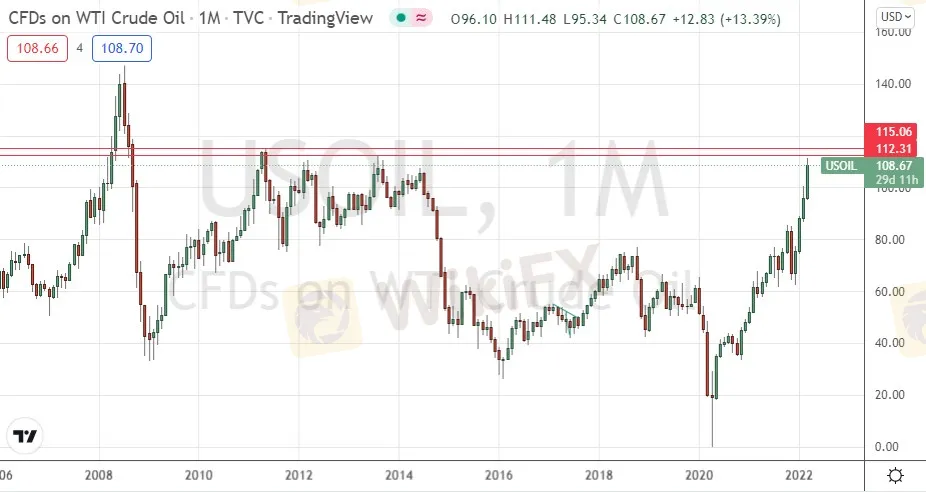简体中文
繁體中文
English
Pусский
日本語
ภาษาไทย
Tiếng Việt
Bahasa Indonesia
Español
हिन्दी
Filippiiniläinen
Français
Deutsch
Português
Türkçe
한국어
العربية
Crude Oil Surges to 8-Year High Above $111
Abstract:As crude oil rockets higher to multi-year highs, what is behind the rise in price, will it continue, and how high can it go?
Crude Oils Dramatic Price Rise
In less than three days, the market price of WTI Crude Oil has risen dramatically, by more than 21%, to reach a new 8-year high above $111 per barrel. The energy commodity has been rising over the long-term too and traded as low as $62 per barrel just three months ago, since when it has almost doubled. While such dramatic movements in the price of crude oil are not unusual from a historical perspective, these are large fluctuations which are likely to have important consequences for the global economy. The proximate cause of the strong jump seen over the past few days is the Russian invasion of Ukraine.

The strong rise in the price of crude oil can be explained by a backdrop of a resurgent post-corona shock global economy colliding with a supply that, while expanding (OPEC have been increasing production by 400k barrels each month for several months now), has simply not been sufficient to meet demand. On top of this factor, we now see Russia, the third largest producer in the world, launch an invasion of Ukraine. This not only increases fear in the markets, which pushes the price of energy higher, it also triggers a real prospect of Russian oil coming off the market or at least parts of it. While western nations, excepting Canada which imports no Russian oil in any case, have refused to extend their new sanctions against Russia to include its oil exports, there is evidence that traders globally are shying away from buying Russian oil today. There are also supply chain disruptions affecting Russian exports.
Another factor is OPECs stated refusal to increase its production further beyond the increases already scheduled to take effect up to April 2022.
Although the International Energy Agency, which includes the USA and Japan amongst its members, announced they would release 60 million barrels of crude oil from their reserves to try to ease supply flow, this was not enough to stem the rise in the price of crude oil.
What Does This Mean for Traders?
At the time of writing, crude oil prices have retreated from the 8-year high made above $111 per barrel just as markets began to open in Europe this morning. However, the retracement we are seeing looks like a normal development and not a major bearish reversal. All the factors mentioned above which have been driving the price higher remain unchanged.
When the price of a commodity such as crude oil is breaking strongly to new multi-years highs, the best bet for a trader is to assume that the trend will continue. Having said that, the question can legitimately be asked, how high can the price go? There is no easy answer, but economists tend to agree that when the price hits $120 it will begin to cause serious problems for economic growth, as crude oil is still the most important energy. There is also the question of the high price of energys impact on an already very high inflation rate. These factors tend to suggest that western nations will try very hard to lower the price. However, their tools for doing so given the high level of tension with Russia may be extremely limited.
The market will also probably have some memory of past key inflection points. The monthly price chart of WTI Crude Oil shown below suggests that there could be technical resistance at $112.31 and at $115.00.
WTI Crude Oil Monthly Price Chart
Disclaimer:
The views in this article only represent the author's personal views, and do not constitute investment advice on this platform. This platform does not guarantee the accuracy, completeness and timeliness of the information in the article, and will not be liable for any loss caused by the use of or reliance on the information in the article.
WikiFX Broker
Latest News
AI-Driven Fraud: Social Media Fraud Reportedly Soars 28%
HKEX to Open Riyadh Office in 2025, Strengthening Ties Between China and the Middle East
Hong Kong Exchange Pioneers Asia's First EU-Compliant Crypto Index
STARTRADER PRIME: Your Trusted Partner in Institutional Liquidity Solutions
J.P. Morgan Leads with Five Awards in Global $7.5 Trillion FX Market
DON’Ts DURING US Election 2024
Can Blockchain Technology Protect Your Money from Risk?
Trump vs. Harris: Whose policies are Better for US stock investors?
MyTrade Founder Guilty of Crypto Manipulation
Hong Kong Court Rules in Favor of Investors in JPEX Case
Currency Calculator


